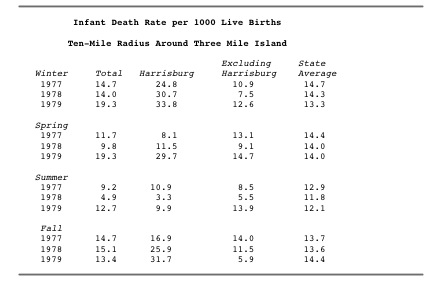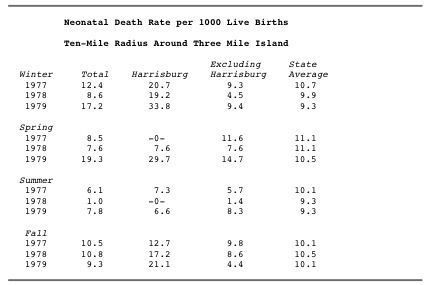March 22, 2011
Infants Died at TMI
By: Aaron Datesman
I have stolen the title of this post from Harvey Wasserman and Norman Solomon’s excellent book, Killing Our Own. I am about to steal their data, too.
Before I engage in this theft, however, I would like to explain again why this historical topic engages my interest at a time when an incredible disaster is unfolding in Japan. Because the historical consensus is that nobody died from the TMI accident, and that as a consequence it wasn’t really a big deal, in my opinion we are failing to understand what the median health effects will be for the population of Japan due to the much larger disaster unfolding there.
TMI killed a lot of people, some miles or some years down the road, and caused increased illness and poor health for many tens or hundreds of thousands more. But in the natural variability of living, health, and time, that signal is difficult to discern. (It scarcely helps that we generally refuse to look for it.) Perhaps this fact indicates that the harm from nuclear power, partial meltdowns and all, is preferable to the harms we also suffer due to other technological choices we make, such as burning coal. George Monbiot makes that argument here. I may have a comment on that idea once I finish what I have to say about the health effects of the TMI accident. I think it’s interesting; but for now, it doesn’t engage me.
This is the data on the infant death rate in the area surrounding Three Mile Island compiled by Wasserman and Solomon from the records of the Pennsylvania Department of Health. The PA State Capitol Building in Harrisburg is a bit more than ten miles north (and a bit west) of Three Mile Island, right along the Susquehanna River. The accident at TMI-2 took place at the end of March, 1979, at the very end of the Winter 1979 time period displayed in the chart. Therefore the Spring 1979 row covers the first months after the accident.

It is difficult to make heads or tails of this data. The sample size is not very large, for one thing. In 1980, the population of Harrisburg was only 53,000, so there are probably in the neighborhood of 300-500 births represented in each quarter. (It is possibly 2-5x more. I don’t know how many people lived inside of the ten-mile radius but not in Harrisburg.) Therefore, it is difficult to view the statistics as robust. Additionally, there is a strong seasonal variation to the death rate in Harrisburg, which confounds interpretation of the data.
However, there is at least one clear signal in the data presented. In Spring 1979, immediately following the TMI accident, the infant death rate in Harrisburg was 29.7 per 1000 live births. In the comparable period from 1978, it was 11.5 per 1000; and 8.1 per 1000 in 1977.
The infant mortality statistics refer to deaths in the first year of life. Neonatal mortality is a subset of infant mortality, referring to deaths in the first month of life. This chart provides the neonatal mortality statistics.

You will note the number in the Spring, 1979 line in Harrisburg: 29.7 per 1000. It is identical to the infant death rate. Wasserman and Solomon explain why this is:
And in those tragic three months after the TMI accident every Harrisburg baby listed as an infant-mortality statistic had in fact died in the first twenty-eight days of life.
What would the results of fallout from a severe nuclear accident descending upon a moderate-sized American city actually be? Dead babies seem a likely one. If you can detach yourself from the conventional wisdom that there were no ill effects due to the accident at Three Mile Island, I think the data show rather clearly that there was a radiological disaster in Harrisburg in the spring of 1979.
If you have ever been to Harrisburg - especially if you’ve driven through - you might note that the Susquehanna bridges are pretty high. With a topographic map, I think one might predict that the likeliest place for TMI fallout to land is also the regional population center just upriver. But to make this connection one must first embrace the basic reality that emissions from nuclear power plants are not magically and immediately diluted in the full volume of the atmosphere once they leave the vent stack at the plant. Unfortunately, this is a reality that many nuclear experts have yet to embrace.
Perhaps no one died as a result of the accident at Three Mile Island. For myself, I think we would come to another conclusion altogether if we really opened our eyes and took the time to look.
— Aaron Datesman